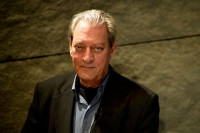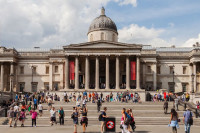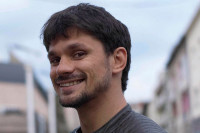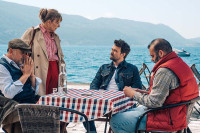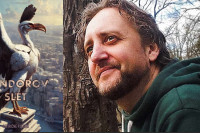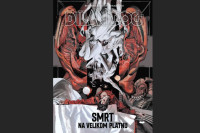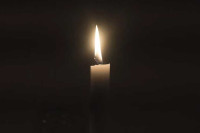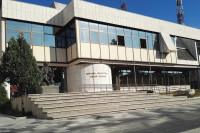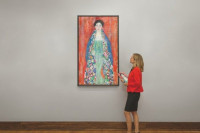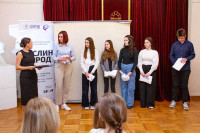Sinziana Ravini, kustos Paviljona BiH na Venecijanskom bijenalu za Glas Srpske: Univerzitet katastrofe je kritička fabrika snova

Umjetnicu impozantne biografije, rođenu u Švedskoj, sa adresom u Parizu Sinzianu Ravini putevi stvaralaštva na obostrano zadovoljstvo, spojili su sa banjalučkim umjetnikom Radenkom Milakom.
Ravinijeva je magistrirala istoriju umjetnosti na Univerzitetu u Geterburugu, doktorirala književnost na Univerzitetu u Hajdelbergu, a trenutno piše drugi doktorat iz psihoanalize na Univerzitetu Diderot Paris 7. I to nije sve. Ona je glavna urednica švedskog "Paletten Art Journala", predaje teoriju na Univerzitetu Sorbona u Parizu, bila je kustos izložbi koje kombinuju umjetnost, psihoanalizu i književnost, pa je sasvim jasno zašto je ona jedan od kustosa Paviljona BiH na Venecijanskom bijenalu "Univerzitet katastrofe". Kada su se poslije napornog rada i svečanog otvaranja "Univerziteta katastrofe" slegli utisci iz Venecije ona je za "Glas Srpske" govorila o saradnji sa Milakom, ekipom Muzeja savremene umjetnosti RS, ideji Paviljona, radu na prestižnom Univerzitetu, problemima 21. vijeka, stvaralaštvu....
GLAS: Šta je to najbitnije za Vas lično, što ste naučili radeći sa Radenkom Milakom i ostalom ekipom na "Univerzitetu katastrofe"?
RAVINI: Prva stvar koju mi je Radenko Milak omogućio bilo je da otkrijem jedan potpuno novi način gledanja i sagledavanja prošlih i sadašnjih katastrofa. Njegove tamne, a opet svijetleće boje i njegovo izuzetno detaljno predstavljanje krhkosti čovječanstva daje tim katastrofama jednu duhovnu, skoro spasonosnu dimenziju, potvrđujući ono što je Blanchot jednom rekao: "Upravo te mračne katastrofe donose svjetlost". Ali, sama svjetlost nije dovoljna. Moramo pronaći način da plovimo kroz katastrofe naših vremena. Projekat "Univerzitet katastrofe" koji su pokrenuli Christopher Yggdre i Radenko Milak može se smatrati intelektualnim i estetskim odgovorom na "The Raft of the Medusa" djelo francuskog slikara Théodora Géricaulta iz 1818 godine - jedan vid kolektivnog nastojanja da se pronađu novi oblici preživljavanja u ovom ciničnom i izuzetno egoističnom svijetu.
* GLAS: Mnogi koji su bili u Veneciji smatraju da je ideja Paviljona BiH/ RS jako snažna. Šta je najljepše bilo u tom procesu rada, kada se skupe različiti ljudi spajajući svoj talenat, znanje, iskustvo u humanu cjelinu zvanu umjetnost?
RAVINI: Zaista sam srećna i ponosna na to što smo uspjeli da spojimo, na izložbenom nivou, dijalog između Milakovih i Uranjekovih radova, a i taj način na koji oni komuniciraju i utiču na druge umjetnike: Lamin Fofana i njegovu "psihogeografsku" zvučnu mapu, emotivni "njunder krammer" Juana Pedra Fabrea, "porno-fantastične" svjetove Sidsela Meinechea Hansena, zatim performans Nillsa Becha i Ide Ekblad o katastrofama ljubavi, a da ne spominjem i istraživanje Loulou Cherinet koje će predstaviti kasnije tokom projekta, Takođe, veoma sam uzbuđena i ponosna na intelektualnu platformu koju smo stvorili sa katalogom koji smo uradili kao i sa specijalnim, duplim izdanjem "Paletten Art Journal" koji se bavi katastrofama i željama koje, kao što možda znate, imaju isti korijen, porijeklo. Ove stvari nisu ništa drugo do rezultat veoma plodonosnog prijateljstva. Christopher Yggdre je igrao veoma važnu ulogu, jer je pozvao Frederika Svenska, Anu van der Vliet i mene kako bi bilo kustosi-saradnici ove izložbe. Mi smo, sa svoj strane, pozvali osam predivnih umjetnika za koje smo vjerovali i znali da mogu da prošire i dorade sam koncept. Radeći na ovom projektu, svaki dan, nekoliko mjeseci, u Parizu sa Kristoferom, Julie Banâtre i Léa Perier, stvarajući katalog je bio jedna istinska avantura, uz neminovna putovanja u Banjaluku i Veneciju. Iza scene, najljepša stvar tokom izložbenog procesa bila je ta razmjena znanja, naše konstantne diskusije, koje su me podsjetile na moje studentske dane. Naš "Univerzitet katastrofe" ima taj kvalitet da ne pokušavamo niti želimo da proizvedemo marketinški - orijentisano znanje. Naprotiv, on stvara ono što bi, zapravo, svi univerziteti trebalo da stvore, a to je platformu koja nam omogućava da kritikujemo svijet u kojem živimo, ali da istovremeno, sanjamo o boljem svijetu. "Univerzitet katastrofe" samim time može biti predstavljen kao kritička fabrika snova koja nam omogućava da pronađemo tačke otpora u ovom razočaranom svijetu. Novembra ove godine, planiramo da organizujemo jedan veliki kongres u Veneciji, sa umjetnicima, filozofima i naučnicima iz cijelog svijeta, koji će nam pomoći da razmislimo i promislimo još jednom o želji katastrofe i katastrofi želje.
* GLAS: Kakav su na Vas utisak ostavili ljudi iz Banjaluke sa kojima ste se družili u proteklom periodu?
RAVINI: Ono što mi se zaista svidjelo kod ljudi u Banjaluci, koji su izuzetno vrijedni ljudi, jeste taj nevjerovatan humor i toplina. Podsjećaju me na lekciju koja sam naučila vrlo rano u životu, a to je da se mnoge stvari mogu postići izuzetnim smislom za humor. Imam to izraženo uvjerenje da se civilizacija ili čak kultura najbolje mogu biti mjeriti njihovim odnosom prema humoru.
* GLAS: Glavna ste urednica švedskog "Paletten Art Jurnala". Koliko imate novinara kakvim temama se bave. Na šta je koncentrisana urednička politika?
RAVINI: Zapravo dijelim poziciju glavnog urednika zajedno sa Frederikom Svenskom, koji je jedan od mojih najstarijih i najdražih prijatelja, jer znate kako kažu, dvije glave su uvijek bolje od jedne. Imamo nevjerovatan uređivački kolegij, sa oštroumnim i izuzetno kreativnim ljudima poput Patrika Haggrena, Fridr Sandström, Maje Hammarén, Antona Göransson i Andreasa Christakisa, koji je ujedno i naš grafički dizajner. Još otkako smo počeli sarađivati i uređivati ovaj magazin 2011. godine, naš glavni fokus je bio na autonomiji. Dakle, kako se izboriti za intelektualni i estetsku autonomiju u svijetu kojim vladaju kapitalističke i fašističke snage? Takođe, naš cilj je da sagledamo kako sistem umjetnosti može da doprinese hegemoniji kapitalističkih, fašističkih i ne tako nebitnih, rasističkih snaga? Proteklih godina objavili smo tekstove poznatih mislilaca današnjeg vremena.
* GLAS: Predajete teoriju na Univerzitetu Sorbona u Parizu. Šta je to najbitnije, što pokušavate da prenesete na svoje studente?
RAVINI: Nastojim da naučim svoje studente da "osjećaju", a ne samo razmišljaju i misle. Svijet umjetnosti već duže vremena stradava od tih nekih apstraktnih teoretskih modela koji nas sprečavaju da saslušamo i priče drugih. Moja predavanja su prilično orijentisanja na pripovijedanje, ali i na "teoriju afekta". Kako pisati i govoriti o umjetnosti na način koji, zapravo, otvara naša srca? Dakle, da skratimo priču, koja je, inače, dugačka; moramo otvoriti naše srce, baš kao što nas je Mali Princ naučio da to uradimo....
* GLAS: Bili ste kustos izložbi koje kombinuju umjetnost, psihoanalizu i književnost. Kroz sve te sfere moguće je analizirati svijet oko sebe. A kako biste vi opsali spoj umjetnosti i psihoanalize?
RAVINI: Pa, umjetnost je najbolji način da otputujete u ono što zovemo besvjesno stanje. I Frojd i Lakan su koristili umjetnost za svoje psihoanalitičke radove. Zainteresovana na koji način kustosi mogu da transformišu jedan izložbeni prostor u putovanje kroz besvjesno, i većina izložbi na kojima sam bila kustos su se bavile željom prodiranja u najskrivenije zone naše svijesti i uma. Jer, tek kada shvatimo i razumijemo sami sebe, možemo shvatiti i razumjeti svijet oko nas.
* GLAS: Mislite li da je moguće pronaći put do pravih vrijednosti i do samog sebe u ovom, po mnogo čemu katastrofičnom 21. vijeku?
RAVINI: U pravu ste kada kažete "put do samog sebe" jer je autentičnost zapravo u jednoj velikoj krizi, još od pojave romantičarskog diskursa. Ko smo mi, zapravo? To je možda i najveće pitanje koje čovječanstvo može postaviti samom sebi. Kada smo istinski iskreni prema samom sebi? Ne znam. Postoji i ono što je rekao Artur Rembo: "Ja sam drugi". Ko je taj što želi u nama, kada želimo nešto? Da li sam to zaista ja ili neko drugi želi to umjesto mene? Možemo pronaći put do samog sebe i biti istinski svoji tek kada pronađemo tu tanku liniju između istinske želje i želja koje drugi projektuju na nas.
Povlačenje i stvaranje
* GLAS: Kada možemo očekivati Vaš dolazak u Banjaluku?
RAVINI: Ne mogu dočekati da se vratim u Banjaluku. Zaista mi se dopada ta topla i prijateljska atmosfera koja proističe iz muzejskog tima, samog grada, prelijepog okruženja, a pritom da ne zaboravim i hranu. Zaista moram da počnem da učim jezik. Jer ko zna, možda se jednog dana preselim u Bosnu. Radenko mi je rekao da imate predivno jezero, nedaleko od Banjaluke, sa kućama koje se mogu iznajmiti na neko vrijeme. Jer, ja s vremena na vrijeme, volim da se povučem iz svijeta kako bih pisala i razmišljala bez bilo kakvog vanjskog uznemiravanja. Ako bi bilo mjesto gdje bih voljela da se povučem, zasigurno bi to bile te kućice pored jezera...
***********
Sinziana Ravini, curator of Bosnian Pavilion at Venice Biennale: "University of Disaster" is a critical dream factory
The artist with impressive background, born in Sweden and living in Paris, Sinziana Ravini was brought by creative pathways towards connection with Banja Luka artist Radenko Milak, to their mutual joy. Ravini got her Master's degree in Art History from University of Gothenburg and her Ph.D in literature, from Heidelberg University. She is currently writing another doctoral thesis on psychoanalysis at University Diderot Paris 7. And this is not all. She is also editor-in-chief of Swedish "Paletten Art Journal" , teaches theory at parisian Sorbonne University, and was curator of exhibitions which combine art, psychoanalysis and literature. And that's why it's quite clear why she is one of the curators of Bosnian Pavilion at Venice Biennale , " University of Disaster "., Ravini talked to "Glas Srpske" about cooperation with Milak and team of RS Museum of Contemporary Art, after heavy work and opening of " University of Disaster ". She talked about impressions from Venice, the idea of Pavilion, work on prestige University, problems of 21st century, creative work...
* GLAS: What was the most important thing you learned from working with Radenko Milak and the rest of the "University of Disaster" team?
RAVINI: The first thing that Radenko Milak enabled me to discover was an entirely new way of looking and reflecting upon past and current disasters. His dark and luminous water colors and his extremely detailed rendering of the fragility of mankind give disasters a spiritual, almost redemptive dimension, activating what Blanchot used to say: « It is the dark disaster that brings the light ». But the bringing of light is not enough. We also have to find a way to navigate through our time’s disasters. The University of Disaster project, initiated by Christopher Yggdre and Radenko Milak, can be seen as an intellectual and aesthetic response to « The Raft of the Medusa » by the French romantic painter Théodore Géricault in 1818 - a collective effort to find new forms of survival in a cynical and highly egotistical world.
* GLAS: A lot of the people who where in Venice think that the idea of the pavilion is very strong. What was the most beautiful thing during the process of coming together with different people, combining their talent, knowledge and experience?
RAVINI: I’m extremely happy and proud of what we’ve succeeded in bringing together, both on an exhibitional level, with the dialogue between Randeko Milak’s and Roman Uranjek’s works, and the way they interacted with the rest of the artists: Lamin Fofana’s “psychogeographic” sound map, Juan Pedro Fabra’s emotional wunder kammer, Sidsel Meineche Hansen’s porno-fictional worlds, Nils Bech’s and Ida Ekblad’s performance of the disasters of love, Geraldine Juarez and Joel Danielsson’s mesmerizing memento mori freezer, not to mention Loulou Cherinet’s research on our time’s disasters that she will present later on in the project. I’m also very excited about the intellectual platform that we’ve created with the catalogue we’ve produced and the special double issue of Paletten Art Journal dealing with disaster and desire that, by the way, share the same root as you may know. These things are nothing but the result of a very fruitful friendship. Christopher Yggdre played a very important role, inviting Fredrik Svensk, Anna van der Vliet and myself to co-curate the show. We invited in our turn 8 wonderful artists that we thought could expand and rethink the concept. Working on this project, every day, for several months, at l’Agence à Paris, with Christopher, Julie Banâtre and Léa Perier, creating the catalogue was a true adventure, not to mention all our trips to Banja Luka and Venice. Behind the scenes, the most beautiful thing during the process of the exhibition was the sharing of knowledge, our constant discussions, that reminded me of my student times. Our disaster university has the quality of not trying to produce quantifiable market-oriented knowledge. On the contrary, it produces what universities should be about, a platform that enables us both to criticize the world that we’re living in, and dream about a better one. University of Disaster can therefore be seen as a critical dream factory that enables us to find points of resistance to a disenchanted world. In November we will organize a huge congress in Venice with artists, philosophers and scientists from all over the world, that can help us think and rethink the desire of disasters and the disaster of desire.
* GLAS: What impression did the people from Banja Luka leave you given you've spend some time together?
RAVINI: What I really adored with the people from Banja Luka, who by the way are very hard working people, was their incredible humour and warmth. They remind me of a lesson I learned very early in life: that most things can be achieved with a strong sense of humour. I have the strong conviction that a civilization or culture can best be measured by its relation to humour.
* GLAS: You are the chief editor of Paletten Art Journal. How many journalists work for you and what topics do you cover? What is the main focus of your paper?
RAVINI: I’m sharing the position of chief editor of Paletten Art Journal together with Fredrik Svensk, who is one of my oldest and dearest friends, since you know, two heads are always better than one. We also have an incredible editorial board, with very sharp and creative people like Patrik Haggren, Frida Sandström, Maja Hammarén, Anton Göransson, and Andreas Christakis, who is also our graphic designer. Ever since we started directing it in 2011, the main focus of Paletten has been “autonomy”. How can we fight for an intellectual and aesthetic autonomy in a world that is ruled by capitalistic and fascist forces? We also look at how the art system in itself contributes to the hegemony of capitalist, fascist, and not least - racist forces. We have over the years published texts by very prominent thinkers such as Chantal Mouffe, Simon Chritchley, Graham Harmann, Pamela M. Lee, Claire Bishop, Sven Olov-Wallenstein, Mikkel Bolt, Ina Blom & Nina Möntmann, just to mention a few.
* GLAS: As a teacher at the Sorbonne University in Paris, what do you concentrate the most on giving to your students?
RAVINI: I try to make my students “feel”, not only “think”. The artworld has for a long time now suffered from abstract theoretical models that prevent us from caring and listening to each other’s stories. My teaching is very storytelling oriented, but also very keen on “affect theory”. How can we write and speak about art, in a way that opens up our hearts? Well, in order to make a very long story short - we have to look with our heart, as The Little Prince in Saint Exupery’s famous novel, learns to do…
* GLAS: As a curator, in your previous exhibitions you usually combine the arts, psychoanalysis and literature. How would you describe the joining of art and psychoanalysis?
RAVINI: Well, art is the best way to travel into the unconscious. Both Freud and Lacan used art as a tool for psychoanalytic readings, both of themselves and their patients. I’m interested in how curators can transform the exhibition space into a journey into the unconscious, and most of my curated exhibitions have dealt with the desire of penetrating the most hidden zones of our mind. It’s only when we’ve understood ourselves that we can start understanding the world.
* GLAS: Is it possible to find value and connect to our true selves today, given that we are surrounded by social media that promotes false lives, reality program and everything else that the 21st century has brought upon us?
RAVINI: You’re right to say “our true selves”, since authenticity has been in crisis, ever since the arrival of romantic discourse. Who are we? That’s perhaps the biggest question that mankind can ask itself. When are we true to ourselves? I don’t know. “Je est un autre” (I is another) said Rimbaud. Who desires in us, when we desire? Is it really me, or someone else, desiring in my place? “Desire is the Desire for the Other”, said Lacan. We can only become true to ourselves when we discover the very fine line between our true desire, and the desires that other project on us.
* GLAS: Can we expect a visit to Banja Luka soon?
RAVINI: I can’t wait to return to Banja Luka. I really love the warm and friendly atmosphere emanating from the museum’s team, the city, the beautiful surroundings, and not least, the food! I just have to start learning the language. Who knows? One day, I might even move to Bosnia. Radenko told me that you have a beautiful lake, not far from Banja Luka, with houses that one can rent for a while. I love withdrawing from the world, now and then, so I can write and think without any external disturbance. If there is a place I would like to withdraw from the world, it would most certainly be one of those houses, on the edge of a lake in the Bosnian country side…
By ALEKSANDRA MADŽAR, photo: D. Danilovic
Pratite nas na našoj Facebook i Instagram stranici i Twitter nalogu.
